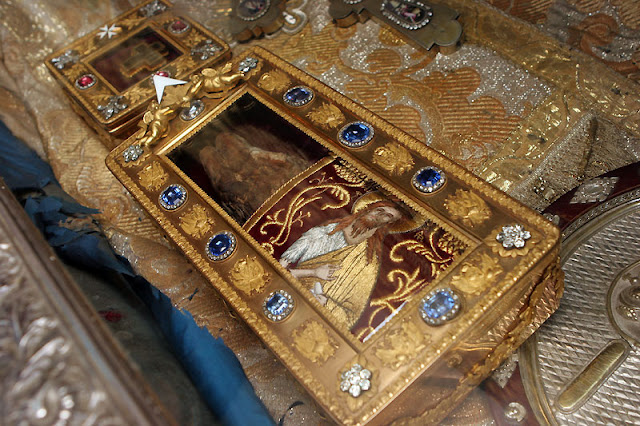The Orthodox Church celebrates the Synaxis of John the Baptist and the translation of his right
hand from Antioch to Constantinople. According to the Church’ tradition, John
the Forerunner of our Lord, was buried in the city of Sebaste, Samaria. Saint
Luke the Evangelist wanting to move St John’s whole body to Antioch, was able
to obtain and translate only his right hand.
Historians Theodoret and Rufinus mention that
the tomb of St. John the Baptist was desecrated in 362, during the Emperor
Julian the Apostate reign, and a part of St. John relics burned. What remained
intact from Saint’ body was taken to Jerusalem, then to Alexandria, and on May
27, 395 was placed in the church that bears saint John’ name.
The chronicle of John Skylitzes (a Byzantine historian of the eleventh century)
states that the right hand of St. John the Baptist was moved from Antioch to
Constantinople in 956 by Emperor Constantine the VII or Porphyrogenites
(913-959) to be placed in one of the chapels of the Grand Palais, that is in the
church of the Most Holy Theotokos of Peribleptos.
At the end of the twelve century, the Russian
archbishop Anthony of Novgorod who went on a pilgrimage to Constantinople,
mentions in his writings among other treasures of this church, the right hand
of St. John the Baptist.
According to Du Cange in 1263, Othon of Ciconia
attested the presence of a small piece from St. John’ right hand, in Citeaux
Abbey, France. In 1261, Othon aceepted the refuge of the Latin Emperor of
Constantinople Baldwin the II and in exchange for a gift, the emperor gave
Othon this piece of relic of St John.
In a testimony of the Spanish ambassador Clavijo
dated 1404, it is mentioned that the holy hand was still in the church of the
Theotokos – Peribleptos in Constantinople. After the fall of Constantinople (in
1453), the hand of St. John the Baptist along with other Church’ treasures were
seized by the Turks and kept in the imperial treasury.
In some Turkish fiscal archives from 1484 kept
in Topkapi, it is noted that Sultan Bayezid the II (1481-1512) sent the hand of
St. John to Hospitallers from Rhodes, (who occupied this island during the
first quarter of the fourteenth century), in order to earn their favor. Later,
the Hospitallers took the relics to the island of Malta, where they established
their qurter.
In 1799, St. John’ hand was translated from
Malta to Gatchina (Russia) when the Russian Emperor Paul the I (1796-1801)
became the Grand Master of the Order of Malta, but also due to threats of war
from Napoleon. This event is also mentioned in the Russian sinaxaryum, from
October 12. From 1799, the relics stayed in the possetion of the Russian tsars,
but in 1917, they were taken out of the country by Maria Feodorovna, fearing
the anger of the Bolsheviks. Since 1917, the right hand of John the Baptist was
preserved in Germany, then in Yugoslavia and presently is found in the
Monastery Church of Cetinje from Montenegro.
In June 2006, during a two weeks period, the right
hand of St. John the Baptist returned in procesion to Russia. Hundreds of
thousands of pilgrims venerated the holy relics in the cathedral dedicated to
our Savior from Moscow. After Moscow and Nizhny Novgorod, the holy relics were
brought for veneration to Yekaterinburg, Rostov, Minsk, Saint-Petersburg and
Kiev(Ukraine). On July 16, the holy relics of St. John returned to Montenegro.
 However, it seems that part of the right hand of St.
John offered by Sultan Baizid the II to the Order of Hospitallers, returned to
the Ottoman Turks in the late sixteenth century. This piece is currently
preserved in Topkapi [Palace] museum, in Istanbul.
However, it seems that part of the right hand of St.
John offered by Sultan Baizid the II to the Order of Hospitallers, returned to
the Ottoman Turks in the late sixteenth century. This piece is currently
preserved in Topkapi [Palace] museum, in Istanbul.
It is surprising to find Christian sacred relics
in the possession of a sultan… Pehaps because in the Qur’an, St. John the
Baptist is called Yahya, the profet that precedes Isa (Jesus).
The holy relics, as they are preserved today, are
placed in a medieval metal ouches [case], modeled in the shape of an arm with
realistic artistical accents. This ouches is undoubtedly the work of a Venetian
workshop, as the case is inscripted with two silver marks: one representing the
Venetian lion and the 2nd mark is a Maltese Cross – sixteenth century style,
the era when the Order of Hospitallers became the Knights of Malta.
The finger gesture is a sign of blessing – commonly
found in the Byzantine art, but also a gesture by which Saint John points at
Christ as “the Lamb of God”. The ouche bares three inscriptions: one around the
wrist noting: “the hand of John the Baptist”, a second on the index finger,
referring to the sermon of St. John depicting Christ as the Messiah: “Behold,
the Lamb of God”, and a third inscription located on the elbow which mentions
the name of a certain monk: “A prayer of God’s servant Daniel.”
Small pieces from the right hand of St. John are also
found in the Monastery of Dionysiou from Mount Athos, and the Coptic Monastery
of Saint Macarius the Great from Sketis, Egypt.
Source: https://orthodoxword.wordpress.com/2014/01/07/the-right-hand-of-saint-john-the-baptist/
|




















CONVERSATION